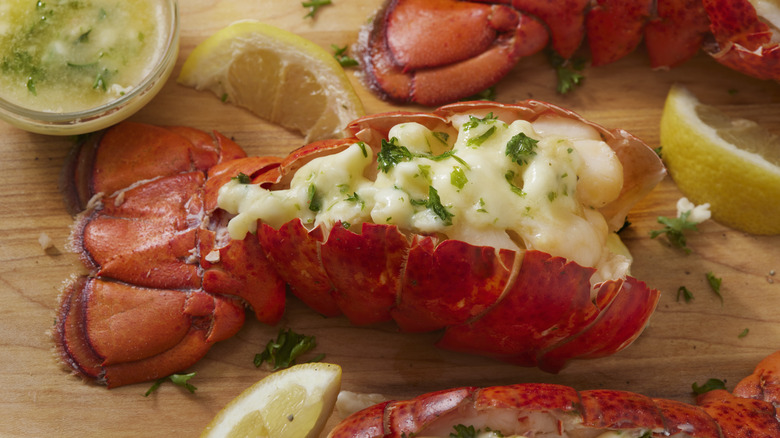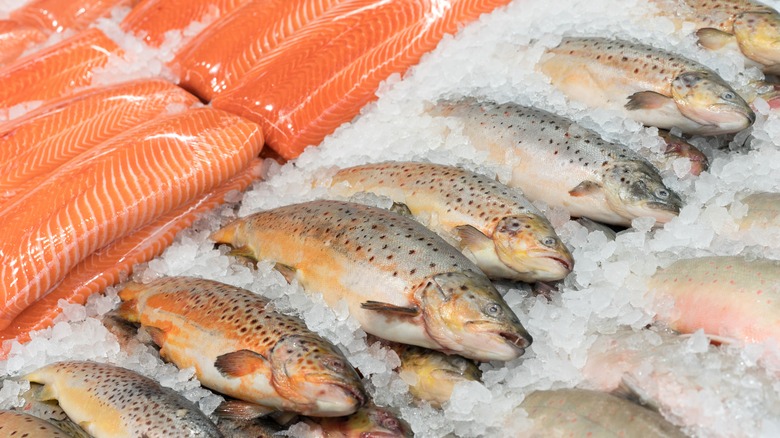The Factors That Contribute To The 'Market Price' Of Seafood
Seafood is one of the most popular global cuisines. The U.S. eats more than $100 billion annually, and it isn't even the biggest consumer. Per capita, America only ranks 11th on the global list (Asia consumes 72% of the total global fish market). And one of the most interesting aspects of seafood compared to other proteins is how often it doesn't have a listed price but is instead marked as "market price."
You don't see this with steak or chicken. But fresh fish filets, lobster, and oysters get this treatment all the time. So, what gives? Why are seafood prices so variable?
It turns out that what contributes to "market price" isn't one variable, it's several — all of which are based on the high degree of variables involved in the fishing and transporting process. (And no, none of the factors are "just because the restaurant thought they could get away with overcharging for this item.")
One of the biggest factors is the weather
When people think of a seafood dinner, they don't usually think of the weather — but maybe they should. For fishermen, there's no greater variable of success than Mother Nature. It's the old supply and demand thing. Bad weather leads to fewer boats on the water (because fewer crews want to take the risk), leading to fewer sources of fish that day, leading to higher prices for the fish available.
Seasonality also affects market price, although this is more of an issue with crustaceans than actual fish. Supply for crab is highest during the summer due to ease of fishing — but most of what's caught then is going to be soft-shell, which doesn't travel as well. Lobsters, meanwhile, are much harder to catch in winter because they retreat to the warmer waters of greater depths, meaning the price will increase.
So, why are some seafood prices (mainly fish, rather than crustaceans) at restaurants stable, while others vary so wildly? Most often, it's because the stable prices are from farm-raised seafood, which isn't subject to the same whims of the elements, as fish are raised in controlled aquaculture environments. This isn't always true — there are certainly restaurants that have wild-caught seafood for a stable price — but it's the most common reason.
The nature of global trade and freshness has just as much of an impact
For all that the weather affects the seafood market, the nature of the global economy (and the difficulties of transporting a delicate product, such as seafood, through that economy) also factor in heavily. Variables such as trade tariffs and just general politics shift frequently, changing the market rates in those countries. And because everything is interconnected, when rates change in one country, there's a knock-on effect in others. China's zero-COVID policy, as well as its increased lobster tariffs, for example, reduced lobster consumption there over the last three years, leading to reduced prices in the U.S due to an abundance of supply.
COVID-19 has also changed the nature of the game when it comes to fresh catch vs. frozen. People started to eat a lot more frozen fish in 2020 than they were pre-pandemic, in large part because it's cheaper (frozen fish isn't subject to a lot of the same volatility as fresh). But in the process, they discovered that by and large, frozen fish actually taste pretty good, so a lot of people have stuck with that approach. The increased reliance on frozen fish in the home market has knock-on effects in the restaurant market, further altering "market price."
Ultimately, the variance in "market price" is a complex question with no easy answers. A hundred variables can affect the finished product, and change your restaurant meal from affordable to wallet-crunching.


